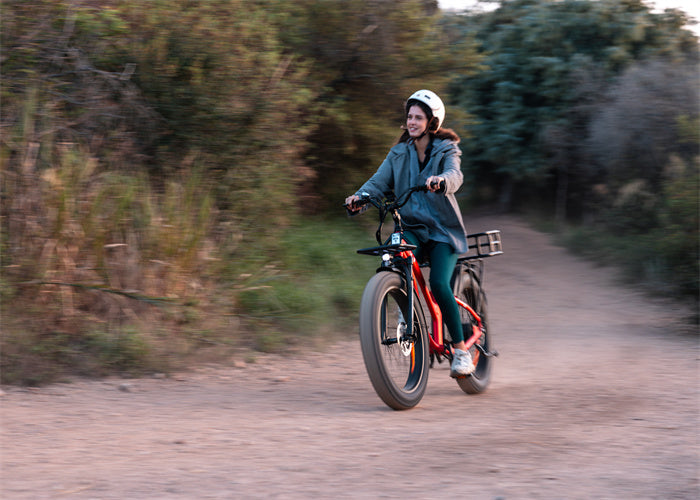A speed limiter on an electric bike is a built-in feature designed to restrict the maximum speed the electric motor can propel the bike.
This ensures the eBike complies with local regulations and enhances rider safety by preventing excessive speeds.

How to Take the Speed Limiter off an Electric Bike
It is crucial to understand that removing the speed limiter can void warranties, breach local laws, and increase the risk of accidents. Always weigh the benefits against the potential drawbacks.
Make sure the bike is powered off and unplug the battery to prevent any electrical issues during the process. Locate and open the e-bike controller box, which is usually found on the bottom of the bike or near the battery.
Use appropriate tools to carefully unscrew and open the casing. The speed limiter might be part of the controller or a separate small device with several wires connected to it. Carefully read and understand the controller circuit diagram if available.
SEE ALSO : Why are ebikes limited to 15 or 20 mph
If the speed limiter is controlled via software, you might need specialized programming equipment or software to reconfigure or update the firmware. Access the bike’s settings through the display panel if possible.
Some eBikes allow speed adjustments through the onboard display. Follow the instructions specific to your eBike model to modify the speed settings.
If the speed limiter is a physical component, you will need to locate the specific wires connected to the speed sensor.
Carefully disconnect the wires that limit the speed. Make sure to label each wire correctly to restore if necessary. Some models may require you to cut a specific wire or change the position of a connector.
Before reconnecting all components, double-check all connections to ensure they are secure. Ensure no wires are left loose or improperly connected. Connect the battery and power on the bike.
Conduct a test ride in a safe, controlled environment to ensure the modifications work as intended. Gradually increase speed to verify the limiter has been successfully removed.
Terry, the manager of the Tesway brand, emphasizes that tampering with speed limiters can lead to significant safety risks and legal consequences.
He stresses the importance of considering these factors carefully, as high-speed eBikes can be particularly hazardous in crowded urban environments.
Tom, the engineering designer of the Tesway eBike, offers a different perspective. He believes that while achieving higher speeds can be exciting, the standard speed limits are generally sufficient for most practical applications.
He suggests that the focus should be on safety and maintaining control rather than reaching top speeds.
Fastest Legal Speed for an Electric Bicycle
In general, ebikes in the United States are legally limited to 20 mph for most bike classes. However, certain electric bikes, such as Class 3 models, can legally reach speeds up to 28 mph.
Tesway X5 fat tire folding ebike is a prime example of an electric bicycle capable of reaching the upper limits of these legal speed allowances.
With its robust design and powerful motor, the Tesway X5 can achieve a top speed of 28 mph. Now available at an unbeatable price, reduced from $1699 to just $999. Don’t miss this limited-time opportunity Although some bikes can technically exceed 30 mph, they fall outside the standard legal categories and are subject to additional regulations.
The classification of electric bikes into different classes is crucial in understanding the speed limits:
Class 1 E-bikes are pedal-assist bikes that can go up to 20 mph.
Class 2 E-bikes are throttle-assist bikes that also cap at 20 mph.
Class 3 E-bikes are pedal-assist bikes that can reach up to 28 mph, often termed as speed pedelecs.
Regardless of the model or class, electric bikes are designed to comply with speed limitations to ensure safety and regulatory adherence.
Current Legal Speed Limits for Electric Bicycle
The legal speed limits for electric bikes vary significantly depending on the jurisdiction. In the United States, federal regulations categorize ebikes as bicycles if they have a maximum speed of 20 mph when operated under motor power alone and a motor of less than 750 watts. This standard applies across many states, but local laws can introduce variations.
For instance, California permits Class 3 ebikes to reach speeds up to 28 mph but restricts them from bike paths unless they are on-street bike lanes.
In New York, recently legalized electric bike allow for speeds up to 20 mph for Class 1 and 2, and up to 28 mph for Class 3.
Florida aligns closely with federal regulations, permitting ebikes to operate at speeds up to 20 mph.
Each state has its own set of rules regarding where and how ebikes can be used, emphasizing the importance of understanding local regulations before hitting the road.
Why are Electric Bikes Limited to 15 or 20 mph
The primary reason ebikes are limited to certain speeds is safety. High speeds can exponentially increase the risk of accidents and injuries, especially in urban areas with high pedestrian traffic and complex road networks.
Speed limits are in place to protect not just the rider, but also pedestrians and other road users.
In addition to safety concerns, regulatory bodies impose speed limits to ensure electric bicycle do not pose an undue burden on the infrastructure or create conflicts with traditional bicycles.
The design of bike lanes and pathways often assumes a maximum speed compatible with conventional cycling speeds.
Statistics underscore the potential hazards of high-speed electric bike. According to recent studies, the incidence of traffic accidents involving ebikes has risen in tandem with their popularity.
A report from the National Highway Traffic Safety Administration (NHTSA) highlights that E-bikes involved in high-speed incidents often result in more severe injuries compared to traditional bicycles.
Conclusion
Removing a speed limiter from an E-bike can be strong, promise faster commutes and more exhilarating rides.
However, it is imperative to approach this decision with a full understanding of the potential risks and legal implications.
Tesway’s electric bike, such as the Tesway X5 fat tire folding ebike, offer a robust combination of speed and safety, adhering to legal limits while providing a dynamic riding experience.
Maintaining these limits not only ensures compliance with laws but also enhances the safety of all road users.

FAQs
Can eBikes go faster than 28 mph?
While some eBikes can exceed 28 mph, doing so generally requires modifications that may not be legal or safe.
Is it legal to remove the speed limiter on an eBike?
The legality of removing a speed limiter varies by region. It often voids warranties and can breach local traffic laws.
Why are speed limits imposed on eBikes?
Speed limits are imposed primarily for safety reasons, to reduce the risk of accidents and ensure eBikes are compatible with existing infrastructure.







Share:
2024 Best Electric Bikes for Big Guys —— Quality bikes at an affordable price point
True Price of Electric Bikes | How much do electric bikes cost